Every influencer, regardless of audience size, is always looking for ways to better their account. It is a natural part of the process that allows us to consistently grow and provide value to our audience. The Insights feature on Instagram has all the information you need to improve your Instagram marketing and build a content strategy that works.
Knowing how to read the metrics and analytics that insights provide is the key to understanding what your audience is looking for when they visit your profile. But these numbers and metrics can be intimidating if you don’t know how to read them. In this post, I’m breaking down how to use and read Instagram insights in order to better your content and grow your audience.
How to Get Instagram Insights
In order to access your account’s insights, you need to have a business or creator profile on Instagram. To transfer your personal profile over, you’ll need a Facebook page to connect with your Instagram profile. Once you have that, just follow these steps:
- Go to Settings
- At the bottom, press Switch to Professional Account, and select either Creator or Business.
How to Find Insights on Instagram
Once you have a business or creator profile set up, accessing your Instagram insights is as easy as tapping the menu symbol on your profile, and tapping “insights.”
How to Use Insights on Instagram
Insights are broken down into 3 main categories: Audience, Activity, and Content.
These categories tell you more than just the number of likes, comments, and saves your posts are receiving. They help you understand more about your account’s overall health and progress by looking at your audience’s demographics, behaviors, and patterns.
Understand the Audience Tab
Let’s dive into the Audience tab first. This is where you’ll find important demographic details about your audience, like where they live, how old they are, and when they’re online.
If you’re an influencer and wanting to partner with brands, it’s incredibly important to be on top of your Audience analytics. Brands oftentimes want to see screenshots of your audience so that they know that their target audience aligns with the audience you have. For example, if you’re a travel influencer wanting to work with a large American airline like Delta, but you only have a 4% United States audience, the ROI Delta sees from that collaboration might be disappointing.
Here’s a peek at my podcast Instagram account’s Audience analytics. You can see that the majority of my audience lives in the United States and that the majority of them are women between the ages of 25-34. You can also see that most of my audience is on Instagram between 12 pm – 3 pm, so that would be the best time to post in order to get maximum engagement.
If you’re diving into your Instagram insights and noticing that the demographics of your current audience doesn’t align with the audience you are wanting, don’t panic! There are a few things you can do to start targeting the audience you want:
- Get really clear on your ideal audience member: Don’t just nail down where your ideal follower lives and how old he/she is. What are her favorite hobbies? Does she have disposable income? What’s her job? These questions will help you create an “audience avatar,” and then…
- Create content for that person: Simply by creating more high-quality, high-value content, you will attract the right audience. For example, let’s say you are a fashion blogger and your ideal followers is a 35 year old woman with disposable income that needs fashion and confidence inspiration. But many of your images are sexual and revealing, so you’re ending up with more male followers. Reflect on what kind of fashion images your ideal audience member would want to see.
- Use hashtags that your target audience uses: Make a list of 5-10 influencers you know of that have the type of audience you want and research which hashtags they’re using!
- Stay away from giveaways w/ other influencers: Or at least be wary. “Loop” giveaways are when a group of influencers band together to give away a prize to a random winner. In order to enter, people need to follow all accounts in the giveaway, giving all the influencers a boost in their following. While that seems great on the surface, these types of giveaways can be problematic because you may gain thousands of followers that don’t match your audience avatar. So if you do want to do a giveaway with other influencers, check the demographics of the other influencers in the giveaway and make sure they are aligned with your ideal followers’ demographics.
Keep in mind that shifting the demographics of your audience can take time. If you have a larger following, it will take longer to shift the numbers than if you have a smaller one. For example, it took me 6 months to shift my female followers from 69% to 72% because that’s around a 6,900 person change.
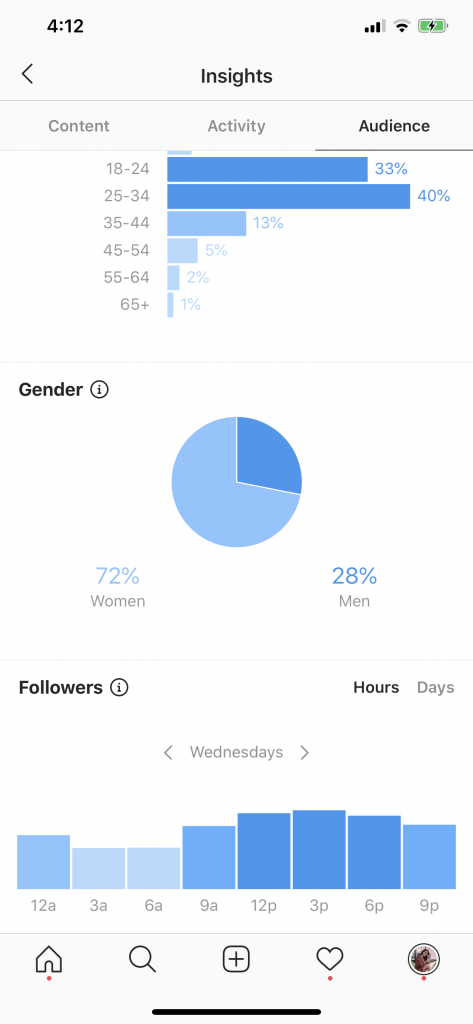
Tracking Your Growth with the Audience Tab
Something else you can do in this category is track your account’s growth. The Audience tab will give you an insight into how much you’re growing on a weekly basis. You can monitor spikes on specific days of the week by clicking on the graph. This will show you the total number of people who followed and unfollowed you on a specific day within a week.
For example, you can see that on May 22nd, 356 people followed me and 155 unfollowed me for a net growth of 201 followers.
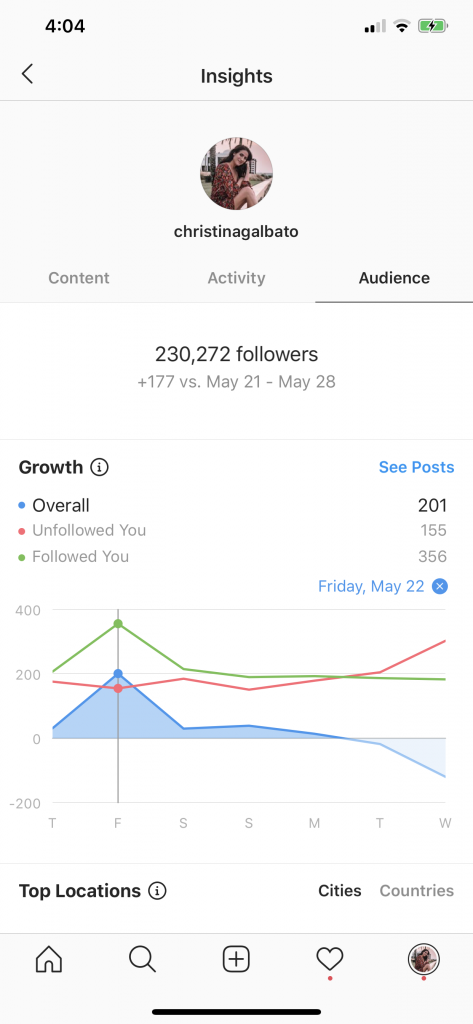
Here’s another hack: Divide the number of people who followed you in the last 7 days by the number of people who viewed your page in the last 7 days (found on your Activity tab). That’s your account’s “conversion rate” a.k.a. the percentage of people who came to your page and followed along. You should always be seeking to improve this!
One thing to keep in mind here is that getting unfollowed is not always a bad thing! A lot of people get down or take it personally when someone unfollows them, but there’s a mindset shift that needs to happen here: your account just isn’t for them and you can’t be for everybody! They won’t interact with your posts, they won’t buy from you, and they won’t be an engaged audience member. It is much better for that person to unfollow you than to stick around as a “ghost” follower and hurt your engagement rate.
Understand the Activity Tab
The next thing you’ll want to look at will be the Activity category, which tells you how your audience is interacting with your content and account.
First, let’s take a look at the interactions section. Interactions indicate what works and what doesn’t work in your current content strategy by the number of profile visits, website clicks, and emails in the last week. You’ll also find a graph that indicates which days most of these actions were taken, so that you can begin to correlate what you posted that day with the interaction your page received.
Reach VS. Impressions
Now that you understand what types of actions your audiences are taking, look at your reach and impressions under the Discovery section. This section indicates how people are finding you and discovering your account. Here’s the difference between reach vs. impressions:
Impressions are the total number of times someone has seen your post through scrolling on their homepage, in a DM, or by clicking through your profile. It’s possible for 1 person to account for 5 impressions, if they saw that post 5 times.
Reach is the number of unique accounts who saw your post. This is where you’ll look to see if the new followers you’re gaining are consuming your content.
With that in mind, it is normal for your impressions to be higher than your reach, as seen in my account here:
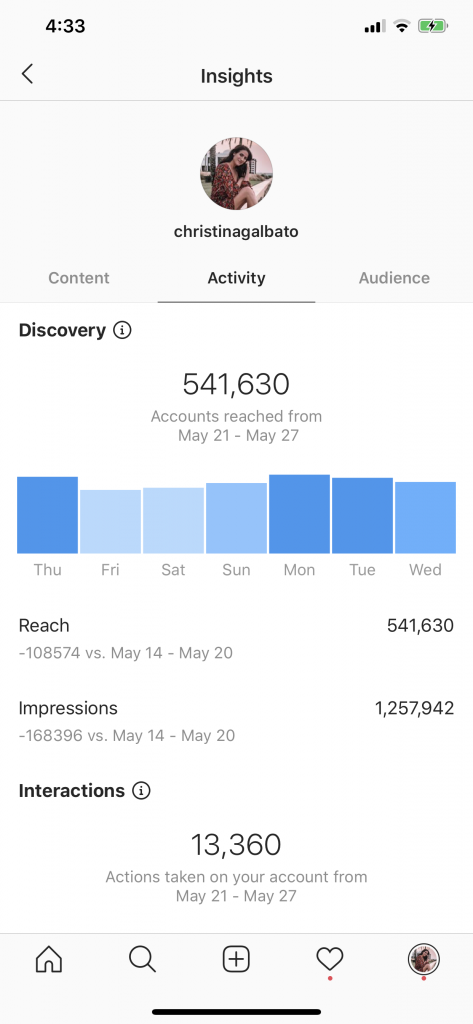
(keep in mind I run ads, so this is not reflective of my organic reach)
Understand the Content Tab
The Content category is where you’ll gain insight into which actions are being taken your Instagram posts. This is where you’ll track performance and find out what types of content is resonating with your audience.
Click the “see all” tab in the “posts” section, you’ll be able to filter and break down content by type (photos and videos, and specific metrics (clicks, comments, engagement, follows, impressions, saves etc…). You’ll also be able to filter and narrow your search down to a customized period of time ranging from 7 days or more.
By filtering your posts through different variations, you can get specific on your content’s performance and hyperfocus on ways to improve your engagement.
Understand Insights on Individual Posts
Moving away from the Instagram insights section, there is also an analytics tool to dive into on individual posts. Doing this will allow you to really improve your content and understand what your audience is reacting positively to so that you can keep creating more of that.
Here’s a screenshot of a recent post:
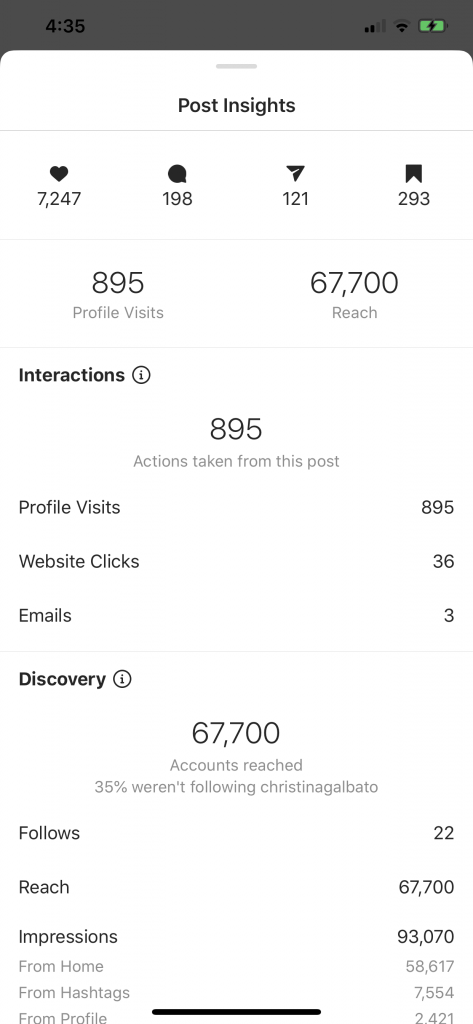
Let’s start from the top with the basic insights. This post received 7,247 likes, 198 comments, 128 shares and 293 saves.
People’s gut instinct here is to focus completely on the number of likes. As I explain in this post about how to adapt to an Instagram without likes and more in detail in the podcast episode, likes are not nearly as meaningful as they used to be. Metrics like saves and shares are far more important to focus on improving because they are a true reflection of how engaging and valuable your posts are.
Moving down, we can see that 895 people visited my profile after seeing this post and the post was seen by 67,700 people. The link in my bio was clicked 36 times and the email button was clicked 3 times.
The discovery section at the bottom is where we can begin to understand how discoverable my post was. 36% of the people who saw this post weren’t already following me, which means that they found this post through hashtags or on the explore page. Sure enough, you can see that 7.554 impressions came from hashtags.
An important number to keep an eye on in your individual post’s analytics is the “[percentage] weren’t following [your account]” because the higher this number is, the more “virality” factor your post has.
If you want to understand more about how Instagram’s algorithm pushes your content out to your followers and how it decides whether to show it to people who aren’t your followers, sign up for the free online class I’m running right now! In it, I walk through this chart explaining the algorithm:
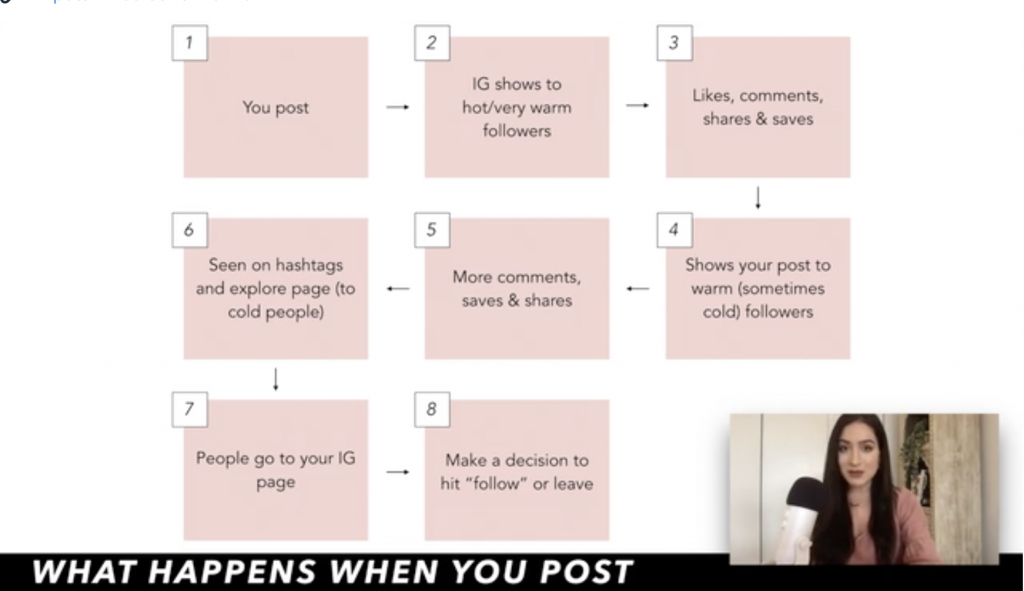
On an individual Instagram Story, you can also view helpful insights like impressions and reach, number of link swipe-ups, replies, shares and profile visits. Use this information to better your stories and make them more engaging!
Setting KPIs
Your knowledge of utilizing insights has to go hand in hand with a goal. In order to track any growth or improvements on your account, you need to set your key performance indicators (KPI) and stick to them.
A key performance indicator is a way to measure and evaluate your account’s success.
Let’s say your goal is to grow your audience, you’ll want to make “reach” your KPI. Similarly, if getting your current following to engage more with your content is your goal, making “engagement” the KPI you focus on can determine if your current content strategy is working. If you’re looking for tips on how you can cultivate an engaged Instagram community, try out some of the tips in this post and keep track of your account’s engagement.
Knowing which KPIs you want to focus on will help you choose the right variations to filter your content through in the content tab. Keep in mind that different types of content usually have different KPIs. For example, you’ll want to make “views” your KPI for videos, “engagement” for photos, and “tap backs” for stories.
Choose a KPI to track and stick with to consistently measure your growth and improvements over time. You can even keep track of your progress in a spreadsheet or Google Doc.

Overall, please remember that – though looking at your insights are important – you are so much more than your numbers.
It’s not about the number of followers you have. It’s about the quality of the relationship you DO have with you audience.
It’s not about the number of people that saw a post of yours. It’s about the impact your post had on the people who DID see it.
Don’t forget to have fun and treat these metrics as nothing more than little nuggets of information that will help you better your account, your marketing efforts and your type of content. Happy ‘gramming!
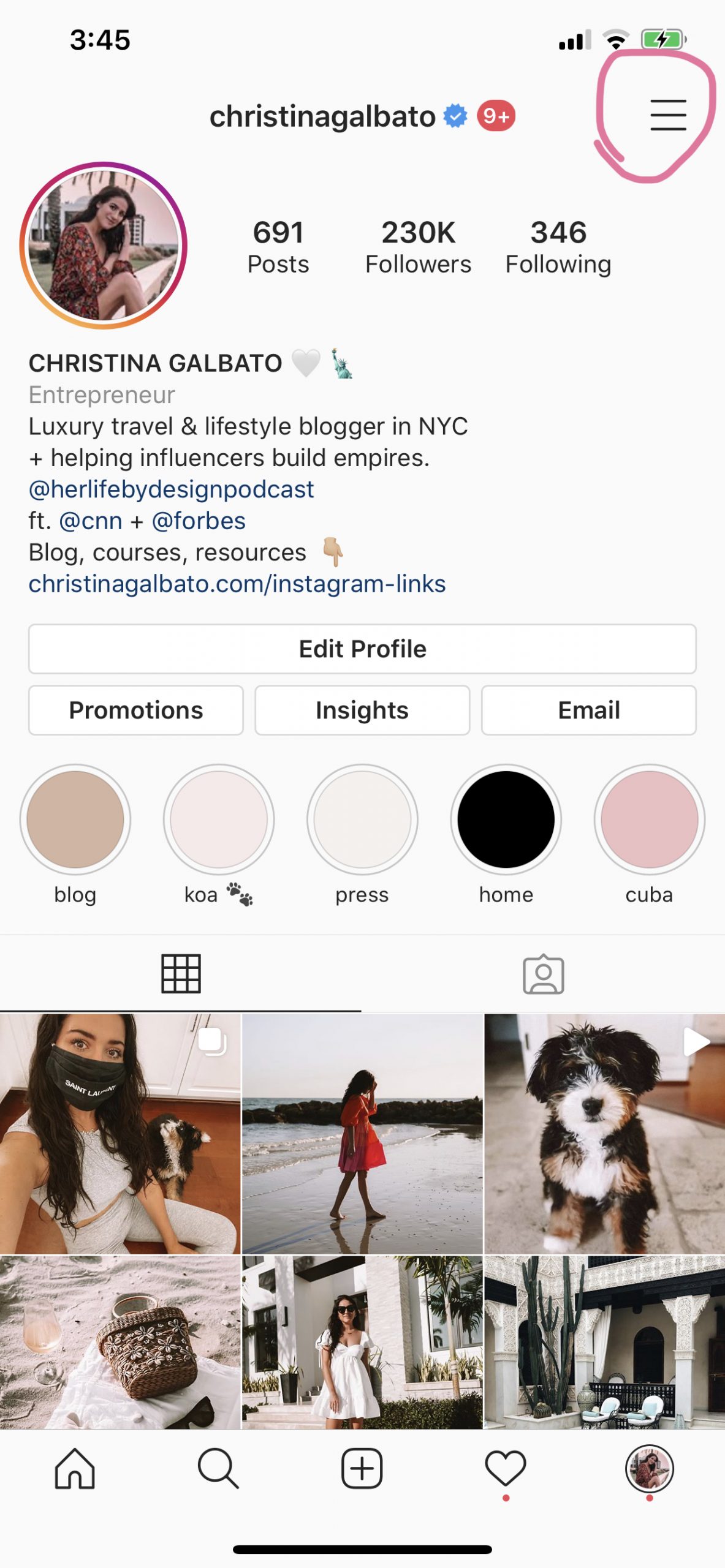
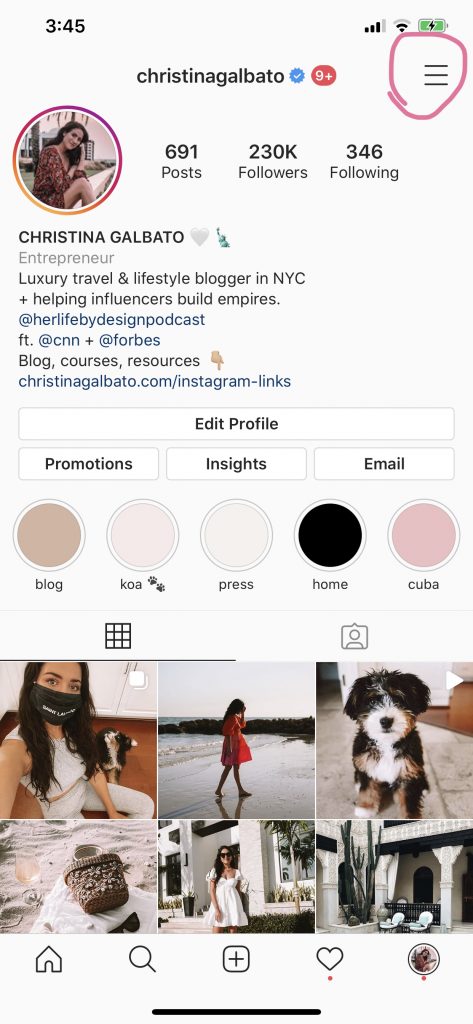
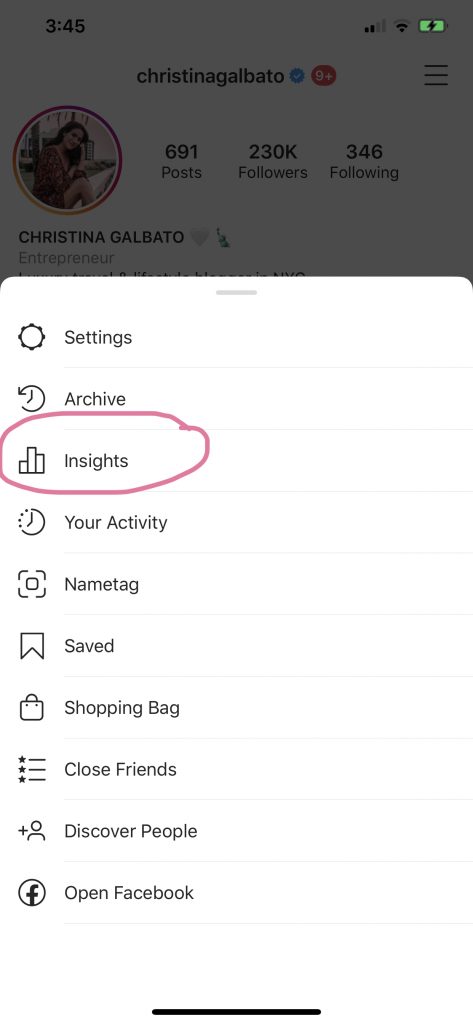
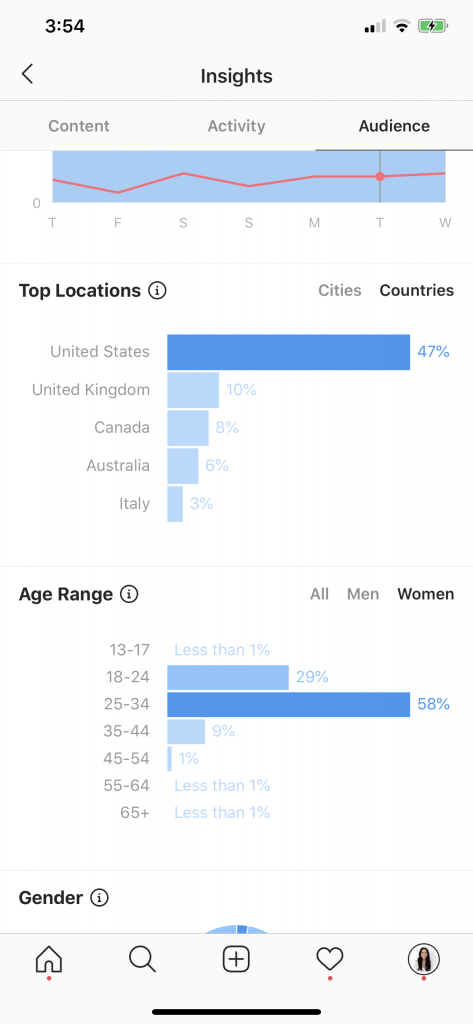
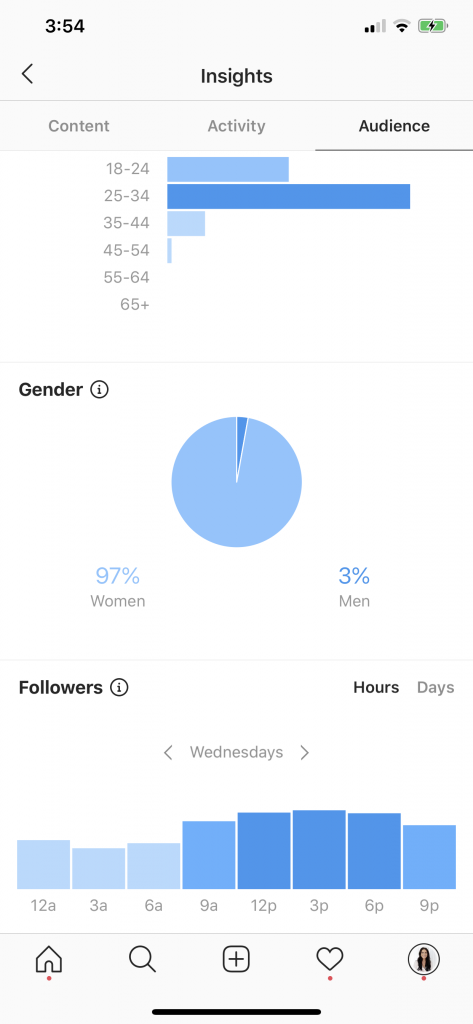

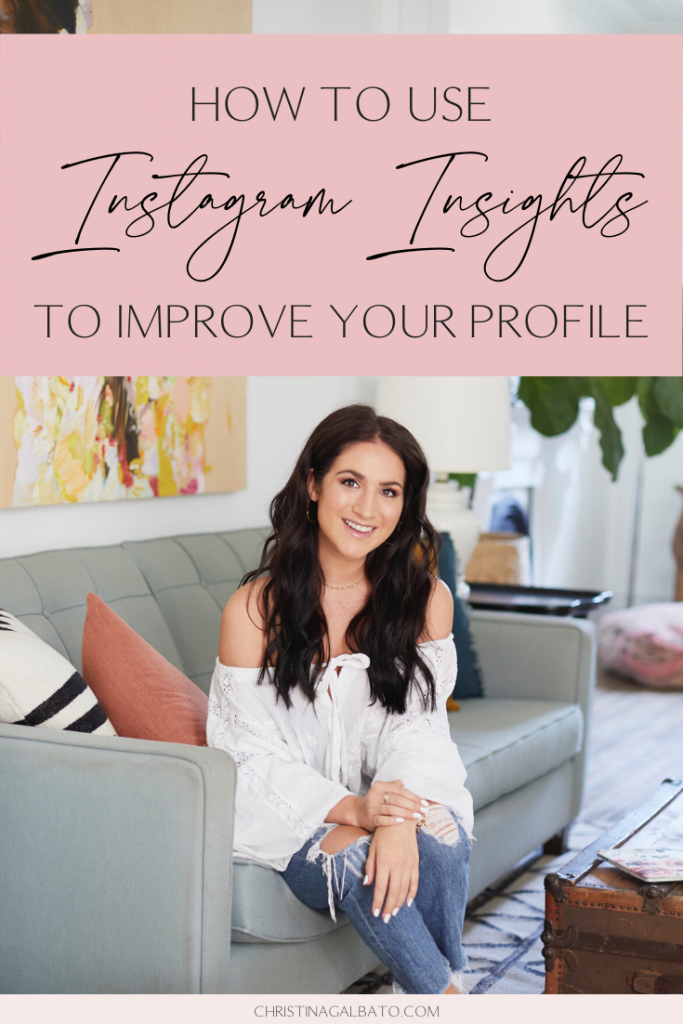
Hey Christina! This blog post was very insightful and I really appreciate you breaking everything down. One question I have it – how do you calculate your engagement rate on Instagram? Thank you!
Great question! Add up the number of likes, comments, shares & saves you have on a post. Then divide that number by the number of followers you have. Then multiply that number by 100, and that’s the engagement rate! xo
Hello, I found this blog very interesting too but a lot to get my head around. What would you say is a good engagement rate to have?
I’m so glad you found it interesting. I know it’s a lot to learn! For smaller accounts, between 5 – 15% is typical, and as your account grows over 50k+, it’ll be more like 1 – 5% these days.